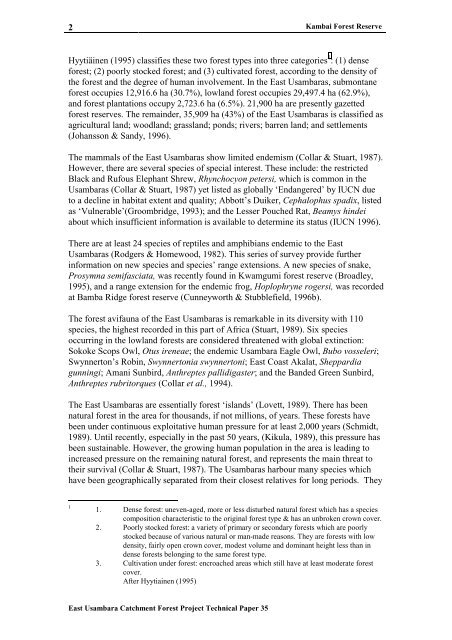East Usambara Catchment Forest Project Technical Paper 35 ...
East Usambara Catchment Forest Project Technical Paper 35 ...
East Usambara Catchment Forest Project Technical Paper 35 ...
Create successful ePaper yourself
Turn your PDF publications into a flip-book with our unique Google optimized e-Paper software.
2<br />
Kambai <strong>Forest</strong> Reserve<br />
Hyytiäinen (1995) classifies these two forest types into three categories 1 : (1) dense<br />
forest; (2) poorly stocked forest; and (3) cultivated forest, according to the density of<br />
the forest and the degree of human involvement. In the <strong>East</strong> <strong>Usambara</strong>s, submontane<br />
forest occupies 12,916.6 ha (30.7%), lowland forest occupies 29,497.4 ha (62.9%),<br />
and forest plantations occupy 2,723.6 ha (6.5%). 21,900 ha are presently gazetted<br />
forest reserves. The remainder, <strong>35</strong>,909 ha (43%) of the <strong>East</strong> <strong>Usambara</strong>s is classified as<br />
agricultural land; woodland; grassland; ponds; rivers; barren land; and settlements<br />
(Johansson & Sandy, 1996).<br />
The mammals of the <strong>East</strong> <strong>Usambara</strong>s show limited endemism (Collar & Stuart, 1987).<br />
However, there are several species of special interest. These include: the restricted<br />
Black and Rufous Elephant Shrew, Rhynchocyon petersi, which is common in the<br />
<strong>Usambara</strong>s (Collar & Stuart, 1987) yet listed as globally ‘Endangered’ by IUCN due<br />
to a decline in habitat extent and quality; Abbott’s Duiker, Cephalophus spadix, listed<br />
as ‘Vulnerable’(Groombridge, 1993); and the Lesser Pouched Rat, Beamys hindei<br />
about which insufficient information is available to determine its status (IUCN 1996).<br />
There are at least 24 species of reptiles and amphibians endemic to the <strong>East</strong><br />
<strong>Usambara</strong>s (Rodgers & Homewood, 1982). This series of survey provide further<br />
information on new species and species’ range extensions. A new species of snake,<br />
Prosymna semifasciata, was recently found in Kwamgumi forest reserve (Broadley,<br />
1995), and a range extension for the endemic frog, Hoplophryne rogersi, was recorded<br />
at Bamba Ridge forest reserve (Cunneyworth & Stubblefield, 1996b).<br />
The forest avifauna of the <strong>East</strong> <strong>Usambara</strong>s is remarkable in its diversity with 110<br />
species, the highest recorded in this part of Africa (Stuart, 1989). Six species<br />
occurring in the lowland forests are considered threatened with global extinction:<br />
Sokoke Scops Owl, Otus ireneae; the endemic <strong>Usambara</strong> Eagle Owl, Bubo vosseleri;<br />
Swynnerton’s Robin, Swynnertonia swynnertoni; <strong>East</strong> Coast Akalat, Sheppardia<br />
gunningi; Amani Sunbird, Anthreptes pallidigaster; and the Banded Green Sunbird,<br />
Anthreptes rubritorques (Collar et al., 1994).<br />
The <strong>East</strong> <strong>Usambara</strong>s are essentially forest ‘islands’ (Lovett, 1989). There has been<br />
natural forest in the area for thousands, if not millions, of years. These forests have<br />
been under continuous exploitative human pressure for at least 2,000 years (Schmidt,<br />
1989). Until recently, especially in the past 50 years, (Kikula, 1989), this pressure has<br />
been sustainable. However, the growing human population in the area is leading to<br />
increased pressure on the remaining natural forest, and represents the main threat to<br />
their survival (Collar & Stuart, 1987). The <strong>Usambara</strong>s harbour many species which<br />
have been geographically separated from their closest relatives for long periods. They<br />
1<br />
1. Dense forest: uneven-aged, more or less disturbed natural forest which has a species<br />
composition characteristic to the original forest type & has an unbroken crown cover.<br />
2. Poorly stocked forest: a variety of primary or secondary forests which are poorly<br />
stocked because of various natural or man-made reasons. They are forests with low<br />
density, fairly open crown cover, modest volume and dominant height less than in<br />
dense forests belonging to the same forest type.<br />
3. Cultivation under forest: encroached areas which still have at least moderate forest<br />
cover.<br />
After Hyytiainen (1995)<br />
<strong>East</strong> <strong>Usambara</strong> <strong>Catchment</strong> <strong>Forest</strong> <strong>Project</strong> <strong>Technical</strong> <strong>Paper</strong> <strong>35</strong>
















